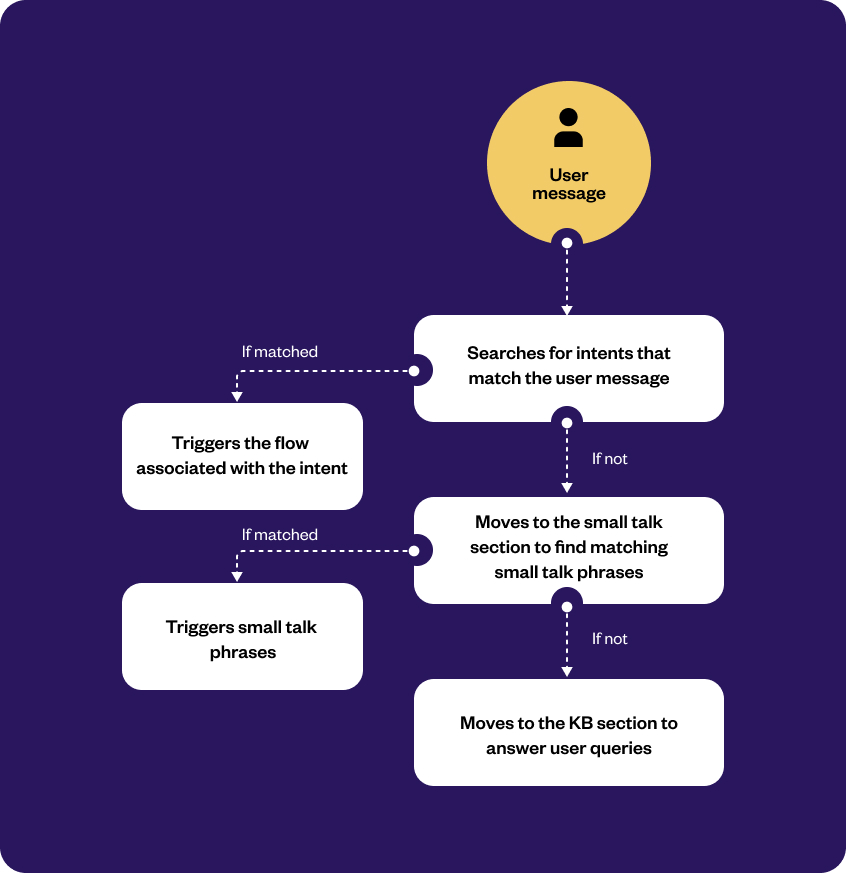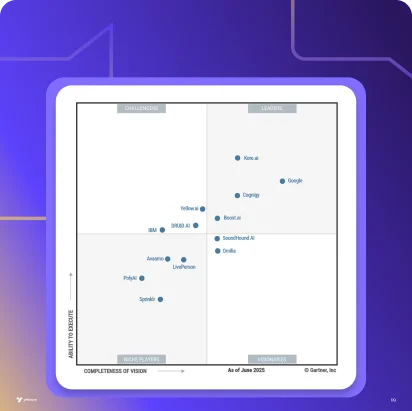Conversational AI has become an essential technology for customer-focused businesses across industries in recent years. More and more companies are adopting conversational AI through chatbots, voice assistants, and NLP-powered bots, and finding tremendous success with them.
These AI-powered tools are like a personal concierge that can help customers with their queries and provide them with the best possible experience. They can understand natural language and respond in a way that feels human-like. Conversational AI is like having a virtual assistant that can help you with anything you need, from booking a flight to ordering food online.
Conversational AI growth market
The conversational AI market is expected to witness significant growth in the coming years, driven by a number of factors, including the rise in demand for AI-powered customer support services and the increasing customer engagement through social media platforms.
According to a report by MarketsandMarkets, the global conversational AI market is expected to reach USD 29.8 billion by 2028, growing at a CAGR of 22.6% from 2023 to 2028.
During the forecast period, the conversational AI market share is projected to experience significant growth due to the increasing demand for AI-powered customer support services. The market growth is further driven by the rising popularity of AI-based Yellow.ai chatbots solutions. Additionally, the adoption of omnichannel methods is expected to boost the conversational AI market growth.
How does conversational AI work?
Conversational AI is a technology that combines natural language processing (NLP) with machine learning (ML). NLP allows machines to understand the meaning of inputs from human users, while ML helps them train on massive data sets to generate responses that are appropriate and relevant to the conversation. Basically, conversational AI is like having a virtual assistant that can understand what you’re saying and respond in a way that feels natural and human-like. The best part is it’s constantly learning from its interactions with humans and improving its response quality over time.
The basic steps involved in conversational AI are:
- User input: The user enters a query or request in natural language.
- NLP: The NLP engine analyzes the user input and identifies the intent of the request.
- ML: The ML engine uses the intent of the request to generate a response.
- Response: The response is then returned to the user.
Related read: How does conversational AI work?
What is the key differentiator of conversational AI from chatbots?
What differentiates conversational AI from traditional chatbots lies in its advanced capabilities and sophistication. While chatbots are typically rule-based and follow predefined scripts, conversational AI is powered by Natural Language Processing (NLP) and Machine Learning (ML) algorithms, enabling it to understand and respond to natural language conversations in a human-like manner.
Also, conversational AI goes beyond simple rule-based responses. It can engage in contextually aware conversations, remember past interactions, and provide personalized recommendations based on user preferences and behavior. This level of contextual understanding and adaptability makes it more dynamic and versatile, enhancing the overall user experience.
Yellow.ai’s conversational AI in particular is designed to continuously learn from new data, interactions, and customer feedback.
This adaptive learning enables it to refine responses and improve performance over time, ensuring that businesses can deliver increasingly effective and customer-centric conversations.
What are the components of conversational AI?
When you start looking under the hood of bots or messaging apps with conversational capabilities, you will generally find the following coming together seamlessly.
If you have plans to develop and deploy a conversational AI system, you should start with these foundational ideas:
1. Performance Data & Analytics
You will need performance and data analytics capabilities on two fronts – the customer data and the customer-AI conversational analytics. It is better to use buyer personas as the building ground to help your AI system identify the right customer. The analytics on your AI system’s interactions will flow into improving its efficacy over time.
2. Cloud storage and processing
You can use Google Cloud for initial deployment. The cloud capabilities will help you store more historical, training, and analytics data. However, once the usage limit has been breached, you will have to start focusing on cost optimization. Microsoft Azure, AWS, Google Cloud, and Snowflake are great alternatives to fulfill your entire cloud requirement.
3. Fluid UI/UX
While you are busy deploying sophisticated technology systems, do not forget that eventually, you are developing a tool for conversational advertising. Hence, the user interface has to align with your brand identity while providing an optimal user experience.
4. NLP, NLG, and machine learning capabilities
Natural language processing, natural language generation, and machine learning are the common forms of technological frameworks you will need. Hence, make sure your internal engineering team or external technology vendor has a clear roadmap for the cloud cost plans, access to talent, and a well-defined repository of tools and platforms to be used in the entire process.
5. Contextual understanding
A proficient conversational AI should possess the ability to retain context throughout conversations. This means it can recall previous interactions and understand the nuances of the ongoing dialogue. By maintaining context, the AI system can provide relevant and coherent responses, making the conversation feel more natural and personalized.
Here’s an example:
Bot: Can you share your email with me?
User: Sure, [email protected] (Expected response)
User: What is an email? Or Why do you need my email? (Received response)
In this scenario, the user asks a question about emails instead of directly providing their email address. To handle these types of contextual intents, contextual responses can be employed to provide appropriate information or address the user’s query.
6. Intent recognition
Accurate intent recognition is a fundamental aspect of an effective conversational AI system. It involves understanding the user’s underlying intention or purpose behind their queries. By precisely identifying this, the AI can then deliver appropriate and helpful responses that directly address the user’s needs. Moreover, a robust intent recognition capability enables the AI to interpret a wide range of user queries, even those expressed with different phrasing or wording.
This results in faster and more accurate responses, minimizing user frustration and improving the overall user experience.
Let’s say that you want to book a flight to Singapore, book a flight is the intent of this case.
On our platform, you can add intents (the purpose of the bot users’ response) and utterances (the various responses used by bot users for a specific intent, for example, to book a flight the utterances can be ‘flight booking’ or ‘book flights’). You need to train the bot to identify and understand these sentences.
However, Yellow.ai’s proprietary NLP model DynamicNLP™ simplifies the process of model training by utilizing advanced technology called zero-shot Learning. This eliminates the need for tedious and error-prone training processes.

7. Easy integration
Seamless integration is an important aspect of an effective conversational AI system that enables it to seamlessly interact with users across multiple communication channels. When integrated with websites, the conversational AI system can appear as chatbots or virtual assistants, ready to assist users with their inquiries or provide support. This integration allows users to access information, ask questions, or complete tasks without leaving the website, enhancing user engagement and satisfaction.
Yellow.ai offers the best of automation and live agents, by providing seamless integrations with industry leading support platforms.
Furthermore, Yellow.ai’s document cognition engine leverages your integrated data from data hubs like SharePoint or AWS S3, transforming it into Questions and Answers on a conversational layer. This capability enables real-time resolution of customer queries effectively.
The drivers of conversational AI
The market for artificial intelligence-driven conversational systems is bound to grow at an aggressive rate. Here are some primary driving forces behind the rise of conversational AI:
1. Need for personalized customer service
The biggest driver for messaging apps and AI-powered bots is the imperative urgency of providing personalized customer experiences. While stores had the luxury of having supporting sales staff, websites, and digital mediums cannot replicate the same experience.
Conversational AI, on the other hand, can provide a more personalized experience across the customer journey.
Elaborating on this, Yellow.ai leverages the power of conversational AI to enhance customer interactions.
At the start of the customer journey, it stands out by offering personalized greetings and tailored interactions based on the customer’s previous engagements. Through its natural language processing (NLP) capabilities, Yellow.ai understands user intent and can provide relevant responses, making the conversation feel natural and human-like.
As customers progress through the journey, the conversational AI system remembers past interactions, ensuring that context is maintained during conversations. The Conversational commerce cloud platform enables businesses to offer personalized recommendations, suggestions, and follow-ups, reflecting a deeper understanding of the customer’s preferences and needs.
Additionally, Yellow.ai’s conversational AI can also analyze customer behavior, interests, and past interactions to proactively offer personalized content, promotions, or relevant solutions. By adapting its responses in real-time, Yellow.ai creates a highly engaging and meaningful customer experience, fostering stronger customer loyalty.
| Pre-Sales | During Sales | Post-Sales |
| Frontend: product recommendations & comparisons | Backend: transaction processing | Frontend: cross-selling |
| Frontend: feature-specific queries | Backend: collecting, aggregating, and segmenting data | Frontend: product query resolutions and customer complaints |
| Frontend: ‘How to’ queries | Backend: forecasting consumer behavior (future purchases, preferences, trends, etc.) |
2. Reduced churn
Tailored, timely, and efficient communication with each customer significantly impacts high retention rates. During the query resolution process, customers may consider opting out of the brand, making it crucial to implement precise and up-to-date conversational AI solutions. Yellow.ai’s Conversational Commerce Cloud solves for this by resolving customer queries efficiently while maintaining a standardized process, ensuring customer satisfaction and retention. With the ability to analyze campaign performance, purchase patterns, intent, and sentiment, businesses can run targeted campaigns to boost average order value, reduce churn, and uplift customer lifetime value by 15%.
3. Reducing operational cost
Deloitte estimates that customer service costs can be reduced with conversational AI systems. This is a fair estimate as most customer queries are near the mean of the normal curve. Human agents can be utilized only when the query is too idiosyncratic. Since the incremental cost per query for using a conversational AI system is marginal, compared to the opportunity cost and expense per minute of having a human agent, the NLP-powered bots can produce tremendous value in the long run by saving costs.
Yellow.ai’s Conversational Service Cloud platform slashes operational costs by up to 60%. Businesses can optimize agent productivity with Yellow.ai DocCog, an advanced cognitive knowledge search engine that extracts critical data from diverse sources. By leveraging DynamicNLP™ and OpenAI API (GPT-3) models, over 1000 routine queries can be automated and internal call deflection rates can be enhanced through DocCog’s reliable fallback strategy.
4. Mapping and executing cross-selling opportunities
Even the most effective salespersons may encounter challenges in cross-selling, relying on a humanistic approach to selling. However, AI bots and assistants are designed to acquire contextual and sentimental awareness.
Yellow.ai, with its advanced conversational AI capabilities, empowers businesses to map and execute cross-selling opportunities effectively. Through Natural Language Processing (NLP), it engages customers in personalized conversations, offering contextual cross-selling recommendations based on their preferences and purchase history. Seamlessly integrated with various communication channels, the platform also ensures a consistent cross-selling experience across platforms.
5. Big data-driven decision-making and predictive analytics
For most online businesses, a lot of data on consumer behaviour is available in the form of heat-maps, traffic graphs, clicks, CTRs, and a dozen other metrics. Segmenting all of this data and allocating it to each user profile is nearly impossible.
Having a conversational AI system that interacts with users and visitors on the website creates a dedicated pipeline for accumulating and segregating data. This helps it create effective segments of the audience with clear guidance of what can be done to convert all the traffic.
Yellow.ai’s analytics tool aids in improving your customer satisfaction and engagement with 20+ real-time actionable insights. From impactful decision-making in customer conversations to chatbot analytics like user feedback, top customer flows, user acquisition details, bot performance, bot activity, etc — you can deep dive into crucial customer analytics and analyze conversations based on the best and poorly performing customer journeys.
6. Business continuity with remote assistance
As the pandemic spread across the globe, more businesses saw a dire need to provide remote assistance.
This created a unique opportunity for businesses that had actively invested in conversational capabilities — the need for automated regular customer interactions with intelligent systems to provide a personalized experience without even being around the customer.
Yellow.ai’s AI-powered chatbots and virtual assistants can handle customer queries and support remotely, providing round-the-clock assistance. They can efficiently address common inquiries, resolve issues, and guide customers through various processes, reducing the need for human intervention.
7. Automated content production capabilities:
Since a pipeline for information is already built on a digital platform’s homepage, a conversational AI system can also generate content that addresses the most frequent consumer queries.
Based on trend analysis and past-query resolution, conversational AI can be used for everything from personalized and conversational advertising to producing textual content for helping users in the form of blogs and FAQs.
Conversational AI vs chatbots : A feature comparison
| Feature | Conversational AI | Traditional chatbots |
|---|---|---|
| Technology | Conversational AI uses clever NLP and ML algorithms to chat with you in a more human-like way. | Traditional chatbots work on predefined rules, so their conversations might not feel as natural and interactive. |
| Language understanding | Conversational AI can understand our language and engage in meaningful conversations, making it easier to communicate with them. | Traditional chatbots might not grasp the full context of what we say, leading to less engaging conversations. |
| Learning capability | Conversational AI adapts and improves over time as it gathers new information from our conversations. | Traditional chatbots might not learn from new data, so they can’t get better with time. |
| User experience | Conversational AI feels like a real conversation partner, making us feel heard and understood. | Traditional chatbots may come across as robotic, lacking that human touch. |
| Complexity handling | Conversational AI can handle a variety of tasks and provide more comprehensive support. | Traditional chatbots are better suited for simple customer support interactions. |
| Analytics | Conversational AI provides valuable insights based on our interactions, helping businesses improve their services. | Traditional chatbots may not offer detailed analytics, limiting their ability to optimize performance. |
How can you develop your conversational AI program?
Step 1: Identify the use-case and define the features
Begin with defining a problem statement. You are engineering a solution to solve this problem. For example – your conversion rates have been going down. You would want an interactive conversational AI system that can help customers navigate easily on your website. Based on the problem statement and the possible solution, you will start seeing the scope of features necessary to make the solution work.
Step 2: Launch a pilot with a beta chatbot
This might seem like a counterintuitive step. But it is highly recommended that you do not start with a full-fledged conversational AI system. Instead, launch a pilot program with a beta chatbot that can be a plug-in on your home page. Post this, monitor every interaction with your customers. Make sure you have enabled the feature of a human agent to take over the conversation.
Step 3: Collect, aggregate, process, and analyze data
At the end of the aforementioned step, you will have enough data on what are the common questions posed by your customers when they interact with a bot. You will also have a clear understanding of where the conversational capability of your static bot fails; this will reflect the gap that your conversational AI system is meant to fill. And finally, you will have some benchmark data to see whether your conversational AI system is performing better than a well-engineered static chatbot.
Step 4: Hire experts for engineering features
In the beginning, you might be tempted to develop the project internally. Refrain from doing this. The entire journey of an AI project is critically dependent on the initial stages. It is difficult to fix an older AI algorithm with just new data. Instead, have a team of experts to help you with creating the exact conversational capabilities you will need.
Step 5: Deploy, monitor, and reiterate
Conversational AI may seem like a great solution. If the implementation is done correctly, you will start seeing the impact of your quarterly results. Retention will improve, CPA will go down, and customer satisfaction scores will go up. However, your goal is to ensure this momentum is retained. Your audiences are dynamically changing. Hence, look at conversational AI systems as evolutionary projects. Put them through stress tests and see their performance. Your systems have to grow alongside the changing behavioral traits of your customers.
Conclusion
While this sounds like a lot to take in, with Yellow.ai’s robust platform, you can simplify the creation of a conversational AI program for your businesses. Its drag-and-drop interface enables easy building of conversational flows without coding.
The inbuilt automated response feature handles routine tasks efficiently, while analytics and continuous learning provide real-time insights for improvement. Additionally, Yellow.ai’s multilingual support caters to a global audience, making it a comprehensive solution for businesses to enhance customer experiences and streamline operations.























